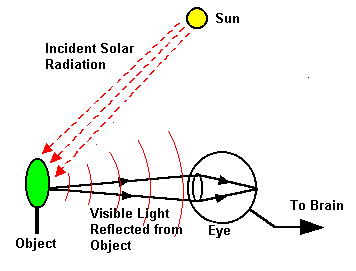 |
 |
 Vision: An Example of a Remote Sensing System
Vision: An Example of a Remote Sensing System
Visual System
The human visual system is an example of a remote sensing system in the general sense. The sensors in this example are the two types of photosensitive cells, known as the cones and the rods, at the retina of the eyes. The cones are responsible for colour vision. There are three types of cones, each being sensitive to one of the red, green, and blue regions of the visible spectrum. Thus, it is not coincidental that the modern computer display monitors make use of the same three primary colours to generate a multitude of colours for displaying colour images. The cones are insensitive under low light illumination condition, when their jobs are taken over by the rods. The rods are sensitive only to the total light intensity. Hence, everything appears in shades of grey when there is insufficient light. As the objects/events being observed are located far away from the eyes, the information needs a carrier to travel from the object to the eyes. In this case, the information carrier is the visible light, a part of the electromagnetic spectrum. The objects reflect/scatter the ambient light falling onto them. Part of the scattered light is intercepted by the eyes, forming an image on the retina after passing through the optical system of the eyes. The signals generated at the retina are carried via the nerve fibres to the brain, the central processing unit (CPU) of the visual system. These signals are processed and interpreted at the brain, with the aid of previous experiences. When operating in this mode, the visual system is an example of a "Passive Remote Sensing" system which depends on an external source of energy to operate. We all know that this system won't work in darkness. However, we can still see at night if we provide our own source of illumination by carrying a flashlight and shining the beam towards the object we want to observe. In this case, we are performing "Active Remote Sensing", by supplying our own source of energy for illuminating the objects.

 The Earth The Earth
 Go to Main Index Go to Main Index
|

